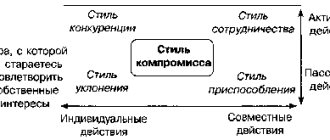Role conflict is closely related to social role, which in turn implies the presence of certain requirements and obligations. In the process of life, people participate in the process of socialization, which implies the presence of a social role. A person can have several social roles, which often contradict each other. The conflict is formed as a result of the fact that a person endowed with a social role cannot fulfill it, does not meet society’s expectations, or has just begun the process of mastering a new role. So what is role conflict, and can it be resolved or avoided completely?
Why does role conflict occur?
The clashes between people, their expectations and ideas, largely depend on the formed norms and rules of society. If a person does not conform to established stereotypes and rules, as well as legal norms for regulating behavior, he experiences a role conflict. You need to understand that it does not appear out of nowhere. First, a person’s action occurs (within the framework of his activity), then his behavior is analyzed from the outside based on the listed mechanisms, then an assessment is given.
Classification
Psychologists identify the following types of role conflicts:
- Intra-role . Appears when a social role involves complex relationships and conflicting expectations in society.
- Interrole . It occurs if an individual has several social roles at once and they have incompatible requirements.
- Personal-role . It happens when the role does not correspond to the values and needs of the individual.
Experts also highlight situational role conflict . It happens when an individual finds himself in a new role for himself, but cannot fulfill it, because he remembers the old role.
A person gets used to new responsibilities and is not ready to immediately express himself fully .
How to avoid role conflict?
Avoiding role conflict is not easy, and sometimes even impossible. However, psychologists identify only 7 principles that will help avoid conflict:
- Tell loved ones about your experiences. The discussion will allow you to analyze the situation again, you will be able to receive unique tips that will help prevent the occurrence of emotional stress and burnout.
- Learn to listen and hear. Important advice, especially for those who often forget to make sure that the existing requirements are complete. Don’t be afraid to talk about your desires, because no one knows about them except you. In situations where role conflict cannot be avoided by any means, the ability to build dialogues will have a significant impact.
- Consider each role and try to love them all. If you enjoy a specific activity, but the obligations are too difficult for you, only love for the functions performed will support you.
- When exploring new places and areas, you should independently take on the development of a new social role. Even if something doesn’t work out due to circumstances beyond your control, continue to treat failure as a new life experience.
- Rationalization of what is happening. Learn to competently assess what is happening to you at the present time. If a requirement is objectively unattainable, then admit it, but don't beat yourself up for not meeting it.
- Ranking of roles. In cases where there are too many social roles and you simply cannot cope with them all, then try to transfer one of them to another person. It is not necessary to transfer the role forever; you can return it back at any time.
- Temporary or permanent removal from one of the roles in order to prevent severe emotional turmoil.
In addition, it is recommended to take preventive measures to combat emotional distress and anxiety. Reducing anxiety and fear will allow you to be calmer, more reasonable and more restrained. If a conflict develops, it is recommended to contact a specialist who will suggest an action plan. The most important thing is that a person should not let go of the brewing conflict; the most favorable situation is when a person is afraid to ask for help from loved ones.
Resolution Methods
From a scientific point of view, there are specific methods for resolving conflict:
Structural
Most often used in the professional field. These include:
- Clarification of requirements. Participants in the confrontation receive clear instructions as to whose competence this or that issue is. The possibility of a conflict is excluded due to the absence of common interests between which a clash could occur.
- Use of special control mechanisms. A clear system of actions is developed and applied in practice when a negative situation arises that can turn into a conflict. The system allows you to identify an emerging dispute at an early stage and eliminate it before moving on to the next stage.
- Setting goals.
Bringing parties together to achieve a common goal will require complete reconciliation and the elimination of any differences. The desire for such a union for the sake of a common goal is observed only with a high level of motivation. That is, the goal must be of high significance for all parties to the conflict. - Application of rewards. The absence of conflicts, the ability to find a common language and reach compromises can be encouraged by a specially designed reward system.
Constructive
How to resist aggression and successfully resolve conflict? Similar methods of conflict resolution are more used in interpersonal communication.
To successfully resolve the situation using constructive methods, it is necessary to form an adequate perception of the situation among the participants, to dispose them to open interaction, to create an atmosphere of goodwill and trust, and to jointly determine the root of the problem.
Construction styles include:
- Liberation from negative emotions. You can free yourself from a negative attitude by using various relaxation techniques, briefly leaving the room, openly expressing your experiences, calmly listening to the opinions of third parties, etc.
- Building a dialogue. Calmed interlocutors share their experiences. Everyone calmly listens to the opponent’s position and then retells in his own words what he heard. This is how a person tries to objectively assess the position of the other side and look at the situation from a different angle.
- Demonstrating a positive attitude. It is necessary to show the other party that, despite the situation that has arisen, there is respect for the opinion of the other person and acceptance of his point of view.
- Analysis of your behavior.
You should frankly evaluate the motives of your own behavior, and adequately determine the degree of significance of your own position for yourself. Often such an analysis leads a person to the conclusion that the essence of the conflict is not so significant for him, and he can easily abandon the dispute that has begun without suffering any losses. - Joint resolution of the situation. The parties together decide to end the dispute (come to a compromise, find ways to solve the problem, etc.).
Integral
Allows each side to feel like a winner. A similar effect is achieved when the parties agree to abandon their original positions, reconsider the situation and find a solution that satisfies everyone.
The method can only be used if the parties to the dispute demonstrate flexibility of thinking and the ability to adapt to new circumstances.
Compromise
The most peaceful, mature way to resolve the situation.
The parties decide on mutual concessions in order to eliminate the negative factors that caused the dispute.
Such behavior of people allows not only to peacefully resolve emerging contradictions without harm to anyone, but also to build long-term communication ties.
The essence of social conflicts
Social conflict - what is it, types
Briefly put, the main essence of role-based social conflict is to overcome contradictory or incompatible demands on the individual from society. Occupying a place in a group, an individual acquires a certain position and is expected to act accordingly.
For your information. Psychologically, it has been noted that if group members understand each other’s roles, realize adequate requirements for their fulfillment, and their role behavior corresponds to situations, then the effectiveness of interaction is guaranteed. In the absence of these characteristics, conflicts arise.
Conflict culture of personality
Regardless of whether there are international conflicts, examples of which most clearly demonstrate the destructive nature of the conflicting behavior of the parties; or we are talking about a minor quarrel between work colleagues, the optimal way out seems extremely significant. The ability of the opposing parties to find compromises in a complex disputed situation, to restrain their own destructive behavior, to see possible prospects for further cooperation with real opponents - all these factors are the key to a possible favorable outcome. At the same time, no matter how important the total role of state policy, economic and cultural-legal systems in society is, the origins of this trend are in certain specific individuals. Just like a river begins with small streams.
We are talking about a conflictological culture of personality. The corresponding concept includes the ability and desire of an individual to prevent and resolve social conflicts (Samsonova N.V.). In this case, it is advisable to recall the concept of “constructive conflict”. Examples of modern conflicts (given their aggravated and large-scale nature) demonstrate, rather, the absence of any constructiveness in conflict interaction. In this regard, the concept of conflictological culture of the individual should be considered not only and not so much as one of the conditions for the optimal resolution of controversial situations in society, but also as the most important factor in the socialization of the personality of every modern individual.
Types of role conflicts with examples
Varieties of role conflicts with examples will help you understand the meaning of the clash of social roles:
- The conflict between different social roles is illustrated by the position of the mother of the family. She is respected in the profession, consulted with, and promoted. In a family, immersed in the household routine, a business woman becomes a typical housewife.
- For a conflict within one social role, an example is the situation: a school graduate with a humanitarian mindset, at the insistence of relatives, goes to study at a technical university. Of course, he will feel out of place. And such a student will not succeed in his studies, there will be no true interest, since everything is subordinated to the word “should”. Conflict: for his family, he is the pride of the family, since he studies at a prestigious university, but is not the most diligent student in his studies.
Status-role
When classifying the types of role conflicts, they are first of all called status-role conflicts. It is also considered interpersonal because the object is either intergroup positions or status in interpersonal relationships.
Status-role conflict often arises in family relationships and becomes the cause of discord between spouses
Why and when may it occur
Experts identify the main reasons why role conflict arises. The main reason is considered to be a situation in which the intended status-role development of the individual does not occur. A typical example is that a person is ready to defend his dissertation, but he is not allowed to do so, believing that it is too early. In addition, role conflict may be due to the following reasons:
- Conflicting roles and needs;
- Mismatch between abilities and role;
- Inadequate performance of the role.
The cause of the conflict may be a mismatch between abilities and role
Causes and meaning
The causes of these conflicts are:
- contradictions initially embedded in the role;
- contradictions that arise between the role and its perception in society;
- contradictions that arise due to the presence of several roles at once, and they cannot coexist together.
As a rule, the established foundations in society, the rules, put pressure on a person . If a role requires the performance of complex actions and a person cannot cope with them, not only an internal conflict arises - experiences, but also an external one, when condemnation by society appears.
The actions of an individual are assessed by others and sometimes highly condemned, which only intensifies role conflict.
Role conflicts arise due to contradictions between the role positions of an individual, his capabilities and corresponding role behavior.
The difference between tension and conflict within a role
We all go through a certain process of socialization. From a young age, children repeat the actions of adults, thereby adopting experience and role-playing behavior. Everyone goes through the process of socialization differently, some have had good experience since childhood, others have not seen anything positive. When a person grows up, he begins to behave according to his position and role. And here role tension can arise - the subject is simply not ready for the demands that the public places on him. To eliminate such tension, students undergo practical training, teenagers learn household management skills, and so on.
Tension increases and leads to conflicts when opposing roles are layered on top of each other. For example, a girl is passing exams, being a successful student, and trying to care for a child, having recently taken on the role of mother.
Sociology of conflict
It has been noticed that most conflicts occur in the sphere of professional activity. It's all to blame for violations of norms and rules that are an integral part of any interaction, for example, etiquette norms and house rules.
In sociology, the following methods of exiting role conflict are most often recommended:
- Conscious highlighting of negative aspects, that is, rationalization, occurs when the role is unattainable. In common parlance - “I didn’t really want it.” So, a woman believes that among men she has no equal, so she is not married.
- Temporary exclusion of one position from life, that is, separation of roles. For example, a person is on a ship on a long voyage, they do not tell him about the death of a relative so that there is no stress;
- Shifting responsibility for consequences to others - role regulation. For example, the habit of some at the peak of action is to step aside, as if to “wash their hands.”
An individual has many social roles in society. If you perform them correctly in accordance with your abilities and requirements, order and comfort in life will be ensured.
Examples of conflict situations
In society
Social conflicts are best resolved using constructive methods.
For example, neighbors of an apartment building may enter into a conflict caused by the distribution of parking spaces in the courtyard area.
Some neighbors will insist on clear markings, according to which each car is assigned a specific parking space. Other residents will advocate for the possibility of free placement of cars.
In this situation, the most effective methods of resolving a dispute will be to build a dialogue and jointly resolve the situation through compromise.
Residents just need to organize a meeting and decide that part of the area in the yard is allocated for individual parking, and the other part remains for supporters of free parking.
Between employees
Disputes in the field of management are best resolved using structural methods.
For example, employees of the same team may come into conflict due to their inability to work together in the same direction.
Each person defines for himself a range of responsibilities that is not approved by his colleague. The result is the emergence of a conflict situation and ineffective teamwork.
The manager of the employees involved in the dispute needs to apply methods of clarifying requirements, setting goals and assigning rewards.
Each employee will be explained the principle of his work and a clear range of job responsibilities. Colleagues will be given joint goals, upon achieving which they will receive the promised reward (bonus, promotion, etc.).
How to resolve conflicts correctly? Find out from the video:
Conflict - what kind of phenomenon?
It should be noted that in order to fulfill a social role, a person needs certain skills and time to learn how to do this. Sometimes it turns out that the same subject must perform conflicting duties. A striking example is the wife-director. At home she should be subordinate to her husband, and at work she should indicate to her subordinates. Because of this, contradictions appear within the individual (internal conflicts) and tense relationships with others. It is precisely because of his status and position in society that certain requirements are imposed on a person. Social role is the behavior of people depending on different requirements for them. One and the same person can simultaneously be a brother, father, son-in-law, worker, friend.
These types of role conflicts differ significantly from each other. Inter-role conflicts occur when the behavior of a person performing different roles does not meet the expectations of others. These expectations and requirements in most cases do not depend on the subject himself. They are formed by public opinion, traditions, and stereotypes. Intra-role confrontations depend on a person’s perception of his behavior in terms of the expectations that his environment has for him. There is a process of layering the ideas of people and their groups onto the role performed by one subject.
Types of role conflicts are complemented by one more: personal-role conflict. It involves a discrepancy between the role and the needs and values of the individual. This type of collision is also considered intrapersonal. Such examples of role conflicts from life are common. Thus, an honest young accountant, trying to do his job correctly, will constantly struggle within himself if his superiors expect him to engage in financial fraud for their own benefit.
Classification of conflicts by the nature of the participants
According to the nature of the participants, conflicts are divided into intrapersonal, interpersonal, conflicts between the individual and the group, and intergroup conflicts.
Intrapersonal conflict - occurs when there is no harmony between various factors of a psychological nature in a person’s inner world, for example, his feelings, values, motives, needs, etc. For example, intrapersonal conflict associated with human activity can be expressed in various forms. But in most cases, this is a form of role conflict - when a person's different roles require him to fulfill different requirements.
EXAMPLE: A person who is an exemplary family man needs to be at home in the evenings, but his position as a manager obliges him to often stay late at work in the evenings. The intrapersonal conflict here is caused by a mismatch between personal needs and the requirements of his activities.
Interpersonal conflict is the most common type of conflict. It may appear differently in different situations. But the reasons for such a conflict can be not only differences in people’s behavior, their manners, views, opinions or characters, which are subjective reasons, but also objective reasons, and they are the basis of interpersonal conflicts most often.
EXAMPLE: One of the most common causes of interpersonal conflicts is the limitation of any resources, such as labor, production space, equipment, money and all kinds of vital goods. For example, one person believes that he, and not someone else, needs resources most of all, while this other person thinks the same way.
Conflict between an individual and a group - the presented conflict appears in cases where one of the members of a group or organization violates the norms of behavior established in it or the laws of communication adopted in informal groups.
EXAMPLE: The conflict between an individual and a group is clearly illustrated by the example of a conflict between subordinates and a leader who adheres to an authoritarian leadership style; Also, similar conflicts can be observed in youth parties, where one of the members of the party suddenly behaved not according to the laws of the “pack.”
Intergroup conflict is a conflict that arises between formal and/or informal groups that are part of a society or organization. It is interesting that during periods of intergroup conflict, people can unite into various close-knit communities. However, this cohesion often disappears immediately after the desired result is achieved.
EXAMPLE: An intergroup conflict may arise between employees of any division of an organization and its administration, for example, due to a sudden reduction in staff; A similar situation is often observed between opposition political parties or religious denominations.
Types of conflicts in literature
There are different types of conflicts in the literature, which can be divided into two main categories: external and internal. A protagonist experiencing internal conflict is usually struggling with himself, trying to make some difficult decision or overcome his own weakness. External conflict is when a character struggles with the challenge of external circumstances, such as other characters, a natural element, or society.
Based on the above, we can distinguish 7 main types of conflicts in literature . Most works focus on one single conflict, but there are also combinations of several in one story. Let's look at them in more detail.
Techniques for reducing role tension
At the psychological level, separation is considered as a technique aimed at reducing role tension. It provides for the individual's ability to ignore the corresponding problem of consistency and consistency. When formulating demands on others, an individual considers them justified only for specific situations. Then role tension is determined by the sayings “To each his own.”
The process of separation depends on the context of a particular situation. It is described as a kind of mechanism of role autonomy. In a situation of inter-role conflict, an individual strives to fulfill a more important role to the detriment of a secondary one. At the same time, he becomes independent in relation to the latter. The individual exhibits a certain autonomy towards it. The same mechanism is also triggered during intra-role conflict.
Delegation involves the ability to distribute role responsibilities. For example, the function of the head of a laboratory is to assign some responsibilities to subordinates. Moreover, he appoints someone responsible for a specific section of the plan, or the amount of work. The manager himself acts as a coordinator. But this technique is limited to a certain limit. Some roles cannot be transferred. The manager will not be able to delegate the function of making decisions, and the student will not be able to delegate exams.
Reducing role connections is one of the most difficult techniques. It is difficult to implement. This is due to the fact that role responsibilities are directly related to the corresponding position. Therefore, if a role set seems difficult for an individual to implement, it is advisable to change jobs. In some cases, institutionalized role reduction is appropriate. We are talking about retirement, or looking for another, simpler role. In this case, you can find executive work instead of management.
Expanding role connections involves a technique that is the opposite of the previous one. It is paradoxical and original. Expansion of role connections is simply to refer to another, more specific role responsibilities, as possible justifications, excuses. An increase in role set leads to a decrease in feelings of tension. But this cannot last long.
Evasion is also an option to avoid the imposition of beginning or ongoing role connections. For example, being in a high position, someone hires a deputy, or in a critical situation decides to take a vacation or simply go on a business trip. In essence, the techniques described actually reflect effective manipulation of the role structure.
How does personality conflict manifest itself?
Psychological science identifies four main types of indicators of intrapersonal conflict. They relate to the emotional sphere, the cognitive sphere, the behavioral sphere, and the fourth type is integral indicators.
Emotional sphere. In the emotional sphere, intrapersonal conflict manifests itself through serious negative experiences and psycho-emotional stress.
EXAMPLE: Depression, stress, apathy, loss of interest in life, etc.
Cognitive sphere. In the cognitive sphere, intrapersonal conflict manifests itself through disturbances in a person’s perception of himself.
EXAMPLE: Decreased self-esteem, difficulties in choosing and making decisions, doubts about one’s motives, aspirations and principles, inconsistency of one’s own image, etc.
Behavioral area. In the behavioral sphere, intrapersonal conflict manifests itself through negative changes in human behavior.
EXAMPLE: Negative background of communication, decreased productivity and quality of activity, dissatisfaction with one’s own activities, etc.
Integral indicators. Complex disorders in the human psyche.
EXAMPLE: Increased emotional and psychological stress, disturbances in the adaptation mechanism, long-term disturbances in a person’s ability to adapt to circumstances, etc.
But, in addition to the fact that intrapersonal conflict can manifest itself in different areas (and even in several at once), it itself is also divided into several types, which significantly complicate both its definition and the development of ways to resolve it. Let's look at them in more detail.
Examples and methods of resolution
There are many role conflicts that affect not only adults, but also adolescents . It is possible to resolve such situations if you make some efforts.
Careerist
An example of such a conflict is a woman who is successful in her professional activities .
She has achieved heights in her career, but when she comes home, she is completely unable to cope with the role of a wife or mother .
It is difficult for her to communicate with children, cook food, and clean the apartment. She either does not have enough time for this, or is simply lost in fulfilling the role of a mother or wife.
To solve this situation, it is necessary to distribute some responsibilities around the house between the husband and children , if the woman cannot cope alone, or the woman herself needs to see more advantages in the role of wife and mother.
She probably doesn’t really like these roles, she needs to show them in a positive light : arrange family holidays, picnics, make a gift with her own hands, show care.
Then she will like this role more, she will want to express herself more with her family.
Small victories in the role of wife or mother will especially help her , namely a deliciously prepared dinner, significant help for children with homework, and handicrafts. Relatives will definitely appreciate this, which will certainly make the woman happy.
Teenager
Another example of such a conflict is a young man growing up .
He is used to behaving like a teenager, taking liberties, having fun, not thinking about serious life issues, but a little time passes and society demands a certain seriousness from him.
The environment can exert pressure regarding the choice of profession, field of activity, or starting a family. An individual may not be internally mature for such questions, but he is forced to.
It turns out that he does not fulfill the role that age imposes on him, there is a discrepancy between internal sensations and socially established concepts.
To resolve this conflict, it is necessary to stop putting pressure on a person and give the opportunity for a certain freedom . The time will come when a person himself will unconsciously fulfill a role appropriate to his age.
He will resolve certain issues himself and avoid internal crises and stressful situations. Sometimes young people need time to find themselves and try on a certain role.
Sometimes it becomes completely unexpected even among the family. However, the choice must be made by the individual himself, without pressure exerted on him.
Change of profession
An equally interesting example is the situation when an individual changes his area of professional activity .
One specialty implied certain responsibilities, but with a change of profession they also changed; the individual needs to get used to the new role.
Very often a person is not ready for such changes : he remembers the old role and does not adhere to the new one. This may give rise to certain misunderstandings on the part of society.
To solve a problem, a person is given time , so he gets used to something new and adapts to new conditions. If he does not fully understand that he needs it, he should be told about it gently, avoiding stressful situations.
Gradually the new role will be learned and accepted by the individual. He will not want to part with her and will be surprised by the fears that troubled him in the past.
Concept
Role conflict is a situation when a person performs a certain social role , but it does not meet his interests or internal attitudes, or the individual simply cannot cope with the responsibilities assigned to him, which this or that role implies.
Psychologists call the role of realizing oneself in society according to one’s strengths, character, and personal qualities.
If a person increasingly dislikes the role, negative emotions accumulate inside and certain attitudes appear. The individual experiences stress, which develops into a crisis. As a result, the person may step away from the role.
For example: a person does not want to be a teacher, but circumstances force him to work in this profession. He is doing something he doesn't like, playing a role that he doesn't like .
As a result, he will either come to terms with his situation, or find another job and stop playing the role of a teacher.
Varieties
There are role conflicts:
- Status-role. It is most popular in families where spouses are fighting for dominance and at this moment do not demonstrate very good relationships.
- Self-concept. It consists in the fact that a person struggles with contradictory thoughts that he has due to the disagreement between his individual abilities and the expectations of society.
- Ambiguous conditions. This type can manifest itself when an individual receives a lot of demands while being within a certain role, which contradicts his intra-role requirement.
- Conflict based on insufficient resources. It occurs when a person cannot express himself due to lack of motivation or education.
In the modern world, a person has to adapt to the rhythm, performing many roles. However, the individual does not always see himself in the role. To feel comfortable, you need to choose roles based on your character, temperament, needs and abilities.








